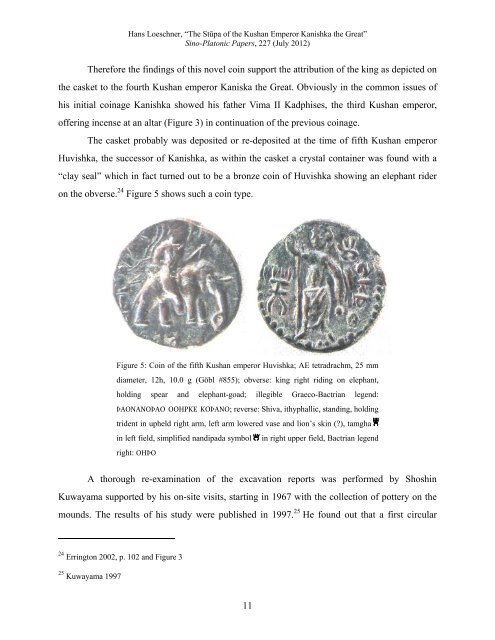The Stūpa of the Kushan Emperor Kanishka the - Sino-Platonic Papers
The Stūpa of the Kushan Emperor Kanishka the - Sino-Platonic Papers
The Stūpa of the Kushan Emperor Kanishka the - Sino-Platonic Papers
You also want an ePaper? Increase the reach of your titles
YUMPU automatically turns print PDFs into web optimized ePapers that Google loves.
Hans Loeschner, “<strong>The</strong> <strong>Stūpa</strong> <strong>of</strong> <strong>the</strong> <strong>Kushan</strong> <strong>Emperor</strong> <strong>Kanishka</strong> <strong>the</strong> Great”<br />
<strong>Sino</strong>-<strong>Platonic</strong> <strong>Papers</strong>, 227 (July 2012)<br />
<strong>The</strong>refore <strong>the</strong> findings <strong>of</strong> this novel coin support <strong>the</strong> attribution <strong>of</strong> <strong>the</strong> king as depicted on<br />
<strong>the</strong> casket to <strong>the</strong> fourth <strong>Kushan</strong> emperor Kaniska <strong>the</strong> Great. Obviously in <strong>the</strong> common issues <strong>of</strong><br />
his initial coinage <strong>Kanishka</strong> showed his fa<strong>the</strong>r Vima II Kadphises, <strong>the</strong> third <strong>Kushan</strong> emperor,<br />
<strong>of</strong>fering incense at an altar (Figure 3) in continuation <strong>of</strong> <strong>the</strong> previous coinage.<br />
<strong>The</strong> casket probably was deposited or re-deposited at <strong>the</strong> time <strong>of</strong> fifth <strong>Kushan</strong> emperor<br />
Huvishka, <strong>the</strong> successor <strong>of</strong> <strong>Kanishka</strong>, as within <strong>the</strong> casket a crystal container was found with a<br />
“clay seal” which in fact turned out to be a bronze coin <strong>of</strong> Huvishka showing an elephant rider<br />
on <strong>the</strong> obverse. 24 Figure 5 shows such a coin type.<br />
Figure 5: Coin <strong>of</strong> <strong>the</strong> fifth <strong>Kushan</strong> emperor Huvishka; AE tetradrachm, 25 mm<br />
diameter, 12h, 10.0 g (Göbl #855); obverse: king right riding on elephant,<br />
holding spear and elephant-goad; illegible Graeco-Bactrian legend:<br />
ϷΑΟΝΑΝΟϷΑΟ ΟΟΗΡΚΕ ΚΟϷΑΝΟ; reverse: Shiva, ithyphallic, standing, holding<br />
trident in upheld right arm, left arm lowered vase and lion’s skin (?), tamgha<br />
in left field, simplified nandipada symbol in right upper field, Bactrian legend<br />
right: ΟΗϷΟ<br />
A thorough re-examination <strong>of</strong> <strong>the</strong> excavation reports was performed by Shoshin<br />
Kuwayama supported by his on-site visits, starting in 1967 with <strong>the</strong> collection <strong>of</strong> pottery on <strong>the</strong><br />
mounds. <strong>The</strong> results <strong>of</strong> his study were published in 1997. 25 He found out that a first circular<br />
24 Errington 2002, p. 102 and Figure 3<br />
25 Kuwayama 1997<br />
11

















